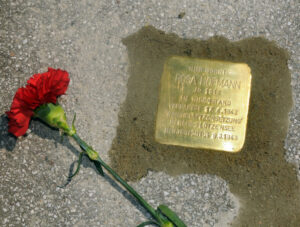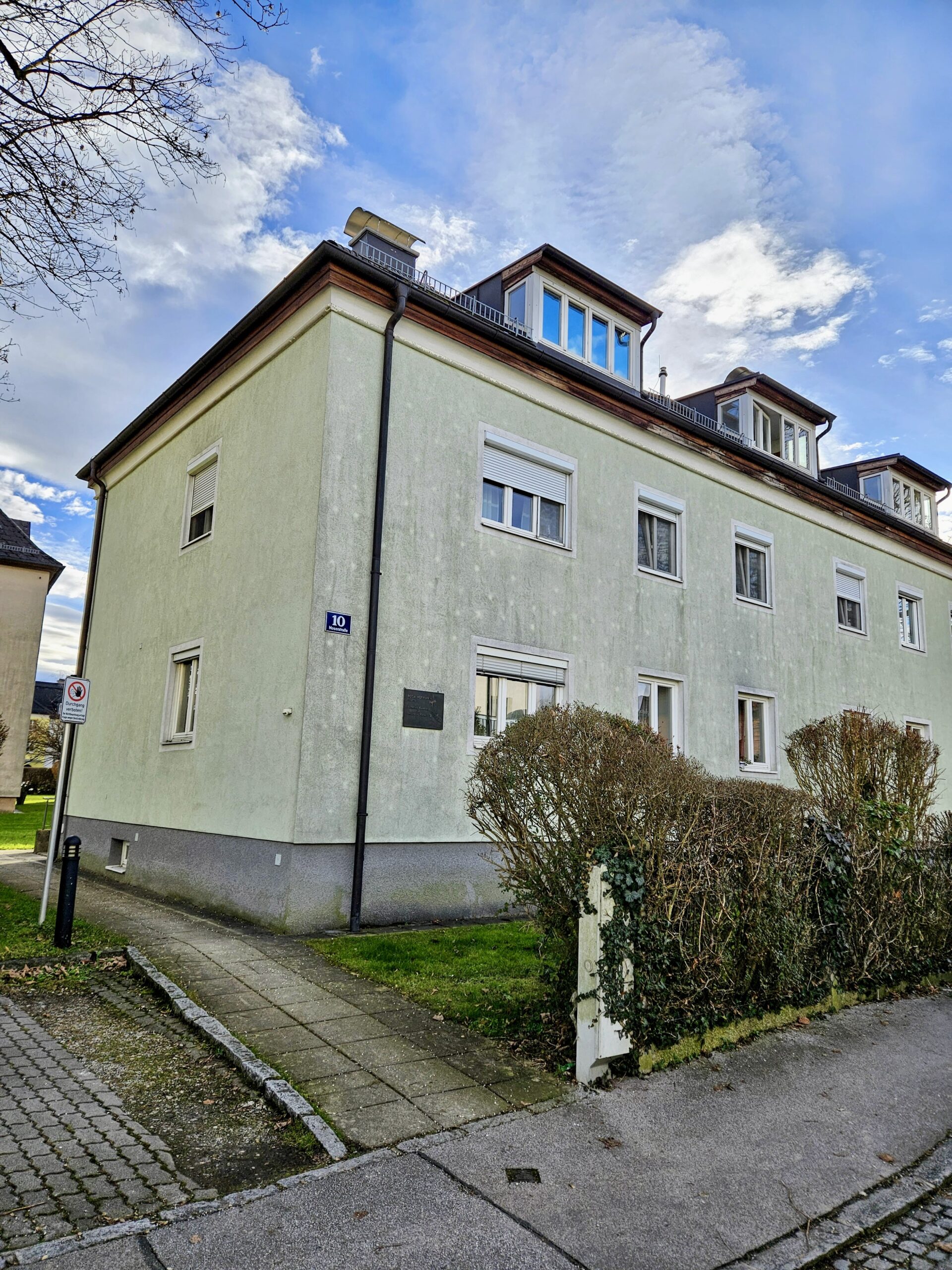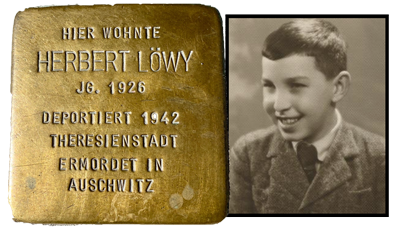Rosa »Ratzi« HOFMANN was born in Wilhering Upper Austria (near the city of Linz) on May 27, 1919 and was baptized in the Roman Catholic Church. She was the third child of Cäcilie (Cilli) and Josef Hofmann.
The Hofmanns lived in Maxglan (which is now part of the city of Salzburg, but which was then an independent community) from 1920 on and they had local citizenship rights there under Austrian law.
The last freely elected Mayor of Maxglan was a Social Democrat and the community was a Social Democratic stronghold. Rosa’s father, a cooper in the Stiegl Brewery in Maxglan and a war invalid from WWI, was a Social Democratic Workers’ Party activist.
He was active in the brewery workers union, leader of the Freethinkers’ League, and group leader in the social democratic party militia –the Republican Defense League.
The worldwide economic crisis at the beginning of the 1930s also hit the Stiegl brewery in Maxglan: beer consumption declined and brewery workers were laid off, including Rosa’s 44 year old father Josef Hofmann.
Josef Hofmann, who still suffered from his severe war wounds, was unable to deal with the news of his layoff and he committed suicide at his workplace on February 7, 1932 – a disaster for his family.
This showed the family and social background that influenced their political resistance.
The Hofmann family continued to live at number 10 Moserstrasse in Maxglan (which became part of Salzburg in 1935). The widow Cilli Hofmann had to go to work as an unskilled laborer to provide for herself and her four children.
Her sons Josef and Anton learned the painter’s and locksmith’s trades. Her older daughter Therese worked as a housemaid and her younger daughter Rosa worked as a seamstress.
The Hofmann children were socialized in the social democratic labor movement of their parents, joining its youth organizations: the Nature Friends, the Childrens’ Friends and the Red Falcons.
After the Austro-Fascists banned all social democratic organizations in February 1934 the Hofmann siblings maintained contact with the activists of the illegal Revolutionary Socialists of Austria (RSÖ).
Therese, the oldest of the Hofmann children, married the bricklayer Franz Holubicka, who was imprisoned by the Austrian dictatorship as the local leader of the Revolutionary Socialists in Maxglan. Therese’s sister Rosa Hofmann was only 18 years old when she gave birth to her daughter Helma on September 26, 1937 and it was a severe blow when Helma died after only 3 weeks. Rosa recovered from the blow and found friends and supporters among the socialist young people of Salzburg’s working class suburb of Itzling – a group of youths who undertook active resistance against the Nazis after Austria was annexed to Nazi Germany.
The Itzling resisters weren’t associated with the Revolutionary Socialists, but rather with the Austrian Communist Party and its Communist Youth league – both of which had been outlawed since 1933.
Strikingly, unlike its socialist counterparts, the Austrian Communist Party declared itself for the restoration of Austrian independence soon after the 1938 annexation by Nazi Germany – something that gave their resistance a distinctly Austrian-patriotic orientation.
In the spring of 1939 the 17 year old barber Franz OFNER started a Communist youth group in Salzburg that focused on educating other young people about fascism and war. Taking up arms and engaging in sabotage were beyond their capability and even encouraging draft resistance was more than they dared.
Neither the Nazi-Soviet Pact of August 1939 nor the German attack on the Soviet Union in June 1941 stopped the political education activities of these youngsters, who included cabinetmaker journeymen Rupert Steiner and Josef »Joschi« Brunauer1, along with Ernst-Paul STOIBER and his girlfriend Rosa HOFMANN – who he recruited in the summer of 1940.
The drafting of 19 year old Franz OFNER in February 1941 followed by that of 19 year old Ernst-Paul STOIBER in September of that year created a major gap in their leadership ranks that led to the 22 year old Rosa HOFMANN stepping in as leader of the Salzburg youth group – and to her undertaking a more leading role in a regional conspiratorial network with her counterparts in Vienna and Linz that was especially dangerous after Nazi Germany had started a war with the Soviet Union in June 1941.
In February 1941 the Communist mechanic Anton REINDL from Itzling had taken over the leadership of the entire regional Communist organization in Salzburg (including its railroaders’, women’s, youth and local organizations), while Anton REINDL’s wife Anna led a women’s cell that included Rosa HOFMANN.
At the beginning of 1942 a Gestapo undercover agent was able to infiltrate the Salzburg based resistance movement and the Gestapo was able to arrest its leaders and crush a resistance movement that extended over a large region.
The Gestapo arrested Rosa HOFMANN on April 17, 1942, a few days after her conspiratorial »Easter trip« with a comrade from Linz.
After a formal arrest warrant on May 9, 1942 Rosa HOFMANN was held in the Salzburg State Courthouse jail.
In the first indictment of the »Peoples’ Court Prosecutor« of June 29, 1942 it stated that in Salzburg and vicinity Rosa HOFMANN had from 1940 to the Spring of 1942 »engaged in and collaborated with others in a highly traitorous enterprise to forcibly detach part of the Reich [Austria] from the Reich and to forcibly change the constitution of the Reich«.
Like most of the activists of the illegal Austrian Communist Party who had set themselves the goal of liberating Austria, Rosa HOFMANN was initially charged solely with »preparation for high treason« (§§ 80, 83 of the German Reich Penal Code).
An extended indictment in October 3, 1942 indicates that as the leader of the Salzburg youth group from September 1941 until April 1942 Rosa HOFMANN maintained contacts with similar minded members of the Communist Youth groups in Vienna and Linz: including Walter Kämpf, Walter Schopf and Eduard Czamler. Elfriede Hartmann, a leading functionary of the Communist Youth League of Vienna also took part in the conspiratorial meetings in Salzburg, but was not named in the files.
Rosa HOFMANN was identified as having taken part in six multi-regional meetings and one together with the Salzburg State Communist Party leader REINDL, where HOFMANN’s apartment in Maxglan had served three times as a conspiratorial meeting place.
In the expanded indictment it was stated that Anton REINDL did not want to condone sabotage or explosives attacks, but he supported the leaflet actions of the Vienna Communist functionaries.
He even had the pamphlets written in Vienna duplicated in Salzburg with the request for the soldiers of the German Wehrmacht to turn their guns around. His youth leader Rosa HOFMANN had to carry out the most dangerous work: the scattering of leaflets on sidewalks and park benches, in telephone booths at the Riedenburg barracks, in toilets at the main railway station and in the passenger cars of the German railways.
Some of the leaflets she distributed read: »We want to put a quick end to this bloody and senseless war, and united in brotherhood with the Red Workers’ and Peasants’ Army, join in the final battle – the fight for a free socialist Europe!«
Unlike most activists of the organized resistance Rosa HOFMANN was not only charged with »preparing to commit high treason«, but was charged further with »treason in aid of the enemy« (§ 91 b of the Criminal Code), and »undermining the military forces of the German people« (§ 5, Abs. 1 of the Special Wartime Crimes Code).
These charges were also brought against some of the activists of the Communist Youth League in Vienna and Linz.2
During the pretrial detention of the youths Rosa HOFMANN, Franz OFNER and Ernst-Paul STOIBER in the Salzburg State Courthouse jail the Gestapo moved to crush the rest of the resistance network forever. Nine wives from the Communist Party Hallein, Gnigl and Itzling locals – including the leader of the women’s section Anna REINDL, were deported directly from the police jail to Auschwitz without any trials or legal processes.3
At least 79 activists from the Communist and socialist resistance groups in the city and state of Salzburg were killed in the Nazi’s concentration camps and prisons.
Held in the Salzburg jail since April 17, 1942, Rosa HOFMANN was transferred to the cells of the Peoples’ Court in Berlin at Berlin-Tiergarten, 15 Bellevuestraße.
On December 15, 1942, when the tide of battle was starting to change with the Battle of Stalingrad, the 6th Panel of the Peoples’ Court under the chairmanship of Walter Hartmanns sentenced the young resister from Salzburg to death and dishonor for »undermining the military forces of the German people in association with treason in aid of the enemy and preparing to commit high treason«.
The death sentence of the »Peoples’ Court« against Rosa HOFMANN said that the severity of her activity lay »in her participation in the spreading of materials aimed at undermining the German armed forces« and that the defendant had »in essence« confessed.
Rosa HOFMANN bravely defended her resistance activities before the court, but she also made it clear that some items in the Gestapo interrogation protocol claiming that the defendant had »been a fanatical communist at the time of the act« and had »hoped for a social betterment from the world revolution« did not correspond to her own words.
On March 9, 1943, after the deaths of several hundred thousand soldiers on both sides of the front at Stalingrad, the 23 year old Rosa »Ratzi« HOFMANN, whose stubborn pride still shines out through the violent rhetoric of the Gestapo and her hanging judges, was beheaded in the Berlin-Plötzensee prison.
Despite the imminence of her execution and convinced of the righteousness of her resistance, »Ratzi« was able to find words to comfort her family even in the face of her death. She wrote:
Beloved mother, sister and brother,
Today I have to say goodbye to you as the appeal for mercy has been rejected. But I am completely calm beloved mother. I thank you, my dear little mother, for your love and I am deeply in your debt for the sorrow that I am causing you. […] if you could see how peaceful I am then your sorrow over me wouldn’t be so great.
Keep me forever in your thoughts. You must remind yourself that so many are dying and know not why. […] who knows what else I would have to do so that no one else will have to go through what I have gone through.
I feel like an old woman and would never be able to be happy. It is good the way it is, believe me. I’ve become tired now.
So, dear little mother, stay healthy – and you too Resi and Tony, be happy and make life good for Mother. I send you my last kisses and warm hugs with a thousand regards. Your RatziBerlin-Plötzensee, March 9, 1943
»Ratzi’s« older brother Josef, who had been drafted at age 23, was killed on the Eastern Front (in the Soviet Union) in September 1942, so his name wasn’t included in her parting letter.
But he was clearly in her thoughts when she wrote »so many are dying and don’t know what for«. On March 17, 1943 the Nazi Salzburger Zeitung newspaper reported the execution of the death sentence against Rosa HOFMANN in Berlin with the headline »Enemy of the State Executed«.
Rosa HOFMANN has no grave as she was one of the 182 execution victims whose names appear on the list of the anatomist Dr. Hermann Stieve.2
He carried out special experiments on the organs of young women in the famous Berlin Charité Hospital.
After the liberation in 1945 he kept his position in the hospital in East Berlin and continued his career undisturbed by the Soviet and East German authorities.
After the liberation of Austria Rosa’s widowed mother Cilli Hofmann received a pension as the survivor of a Nazi victim and died in Salzburg at age 81 in 1968.
On May 4, Mai 1947, two years after the liberation of Salzburg, the Socialist Party of Austria’s Salzburg State organization led by Franz Peyerl opened the first home of the Children’s’ Friends in the Stölzlpark, at Bindergasse 11 in the Maxglan neighborhood – it was named after the »socialist« Rosa HOFMANN.
The memorial stone there carries the inscription:
Rosa Hofmann
died for socialism on March 9, 1943 at the hands of an executioner
You gave your life for freedom
We will try to live up to your example.
In July 1965, at the request of the local Communist politician Heinrich Falterbauer and with the unanimous approval of the Salzburg city council, a street in the Maxglan-Siezenheim neighborhood was named after Rosa HOFMANN.
There is a housing project there now called ROSA ZUKUNFT (Rosa Future).
1 Rupert Steiner was born in Hallein on April 18, 1920. He survived the political persecution (arrest and army service in a punishment unit), and was later the district leader of the Communist party’s »Free Austrian Youth« (FÖJ/KPÖ) and died in Hallein on April 24, 1992.
Josef »Joschi« Brunauer was born in Salzburg on August 4, 1921. He too survived the political persecution (arrest, military service, prisoner of war) and was later a labor union functionary, Socialist Party politician, member of the Salzburg State parliament, State Councilor and President of the Chamber of Labor. He died in Salzburg on September 9, 1999.
2 Death sentences of the Peoples’ Court were carried out against three Communist Youth activists from Vienna: Walter Schopf (killed in Vienna September 9, 1943), Elfriede Hartmann (killed in Vienna November 2, 1943) and Walter Kämpf (killed in Vienna November 2, 1943). The August 17, 1944 Court Martial death sentences for the soldiers Eduard Czamler, Heinrich Schifer and Johann Schaubmair from Linz were never carried out and the three survived.
3 The Salzburg and Hallein women murdered in Auschwitz included: Rosa BERMOSER (killed October 14,1942), Maria BUMBERGER (killed November 17, 1942), Anna FRAUNEDER (killed November 20, 1942), Marianne INNERBERGER (killed November 12, 1942), Josefine Lindorfer (killed November 18, 1942), Anna PRÄHAUSER (killed October 16, 1942) and Anna REINDL (killed August 24, 1942).
In contrast to their seven comrades deported to Auschwitz without any trials, Käthe Schnellinger and Maria Velek were granted criminal trials by the Nazi regime and received prison sentences – and so they survived the terror years.
Sources
- Salzburg city and state archives
- umentation Archive of the Austrian Resistance (DÖW) – two photos
- Salzburger Wacht (the newspaper of the Social-democratic Labor Party in Salzburg), February 8, 1932, p. 5 (Obituary for Josef Hofmann)
- Salzburger Tagblatt (the newspaper of the Austrian Communist Party), October 31/November 1, 1945, p. 3
- Rosa Hofmann’s parting letter in: Widerstand und Verfolgung in Salzburg 1934-1945, vol. 1, Vienna 1991, p. 450
Translation: Stan Nadel
Stumbling Stone
Laid 06.07.2011 at Salzburg, Moserstraße 10

 Rosa Hofmann
Rosa HofmannPhoto: Archive of the Communist Party of Austria
 Memorial for Rosa Hofmann at Stölzlpark (Salzburg Maxglan)
Memorial for Rosa Hofmann at Stölzlpark (Salzburg Maxglan)Photo: Gert Kerschbaumer
 Rosa Hofmann (middle)
Rosa Hofmann (middle)Photo: DÖW
 Rosa Hofmann
Rosa HofmannPhoto: DÖW
 Photo: Gert Kerschbaumer
Photo: Gert Kerschbaumer
 Photo: Gert Kerschbaumer
Photo: Gert Kerschbaumer
 Memorial for woman in resistance against national socialism
Memorial for woman in resistance against national socialismPhoto: Stadtarchiv
 Backside of the memorial »I am longing for you and the mountains ...«
Backside of the memorial »I am longing for you and the mountains ...«Photo: S. Ruep
 Photo: Gert Kerschbaumer
Photo: Gert Kerschbaumer
